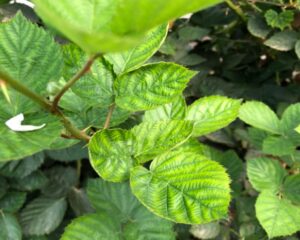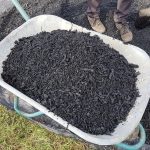Iron in plants
Iron is required for the biosynthesis of the chlorophyll molecule and functions as an electron carrier in the respiration and photosynthesis reactions. In addition, it participates in many enzymatic processes. Iron deficiency is a limiting factor of plant growth.
Iron is present at high quantities in soils, but its availability to plants is usually very low, and therefore iron deficiency is a common problem.
Iron in soil
In soils, iron oxides are formed as a result of weathering of iron-containing minerals, such as olivine, pyroxene, and biotite. Most of the iron oxides in soil are in the form of Fe3+ (ferric iron), which are much less soluble than Fe2+ (ferrous iron). Ferrous iron readily oxidizes to the ferric form and precipitates out of the solution.
The solubility of Fe3+ is highly depended on soil pH. At neutral and high soil pH levels, iron becomes insoluble and therefore, although iron is abundant in many soils, its availability to plants is very low in soils with high pH, such as calcareous soils.
Organic matter and the activity of microorganisms in soils may improve iron availability. Interactions between organic matter and microorganisms with iron minerals form soluble iron compounds over a wide range of pH. Crops growing in low organic matter soils are more susceptible to iron deficiencies.
Iron uptake by plants
Plants can absorb iron both in the ferric and ferrous forms, as well as in the chelated form.
Iron uptake is a metabolically regulated process. Two iron uptake mechanisms were evolved in plants: proton release mechanism and Fe3+ chelate reduction. The purpose of both mechanisms is to make iron more soluble and available for uptake.
Proton release mechanism – Under iron deficiency conditions, plant roots release protons into the soil solution, which reduces the pH the immediate root surrounding and increase iron availability.
Research shows that the source of nitrogen fertilizer used can also affect iron availability for plants. Ammonium (NH4+) is a positively charged form of nitrogen. Uptake of ammonium leads to a decrease of the pH in the rhizosphere (root surrounding). As a result, iron becomes more soluble and available to the plant.
On the contrary, the pH of the rhizosphere may increase when nitrate nitrogen (NO3–) is applied, as roots release hydroxide ions. As a result, iron availability decreases.
Chelate reduction – In iron-deficient soils, gramineous crops (e.g. corn, rice, wheat etc.) secrete organic substances, named phytosiderophores, which act as chelating agents. The phytosiderophores bind iron and make it soluble and available for uptake.
Chelate reduction can also be carried out by certain bacteria in the soil.
Iron uptake is carried out primarily by young roots. Therefore, maintaining a healthy root system is important for adequate iron uptake.
Iron deficiency
Iron is not mobile within the plant and, therefore, deficiency symptoms appear on younger leaves first. Leaves turn yellow and chlorotic, but leaf veins remain green.
Often, iron deficiency is not a direct result of lack of iron in the soil. A variety of soil conditions may affect its availability for plants. Conditions such as high soil pH, high soil moisture, low temperatures, high phosphorus and the high concentrations of competing elements, such as zinc, calcium, and manganese, may reduce the availability of iron to plants.
 Iron deficiency in blackberry
Iron deficiency in blackberry
Therefore, applying iron without considering soil conditions might not help in correcting the deficiency.
Foliar application of iron can help correcting iron deficiencies in the short term. A longer-term solution must include understanding the reason for the deficiency and correcting the conditions that cause it.
In high-pH soils, one of the most common practices, in addition to foliar applications, is the application of chelated iron fertilizers, such as Fe-EDTA, Fe-EDDHA and Fe-EDDHMA. The iron chelates allow iron to be available for plants at a wide range of soil pH levels.
Iron fertilizers
The most commonly used sources of iron are:
Iron sulfate (FeSO4) – typically contains between 20%-30% iron, depending on the hydration state. It is the least expensive iron source. Iron sulfate can be applied as a foliar spray or directly to soil. However, this form of iron is not available for plants at a pH above 7.0 and it may take a soil applied iron sulfate a few years to correct iron deficiencies.
Iron chelates. Chelates are compounds in which iron is combined with a compound that helps keep iron available and avoids its precipitation. Several compounds are used as chelating agents. For example, EDTA, DTPA, EDDHA, (all three are sodium salts), amino acid, humic-fulvic acids and citrate.
Chelates differ in their stability and their ability to hold iron at different pH levels. In addition, the susceptibility of chelates to substitution of the iron by other cations, such as calcium and magnesium, varies among chelate types, as is shown in the following table.
| Iron chelate | pH range at which stable | Affinity to cations | Suitable for… |
| Fe-EDTA | 3.5-6.0 | High affinity to calcium | Acidic soil
Calcium-poor soil
Soilless media Hydroponics (Where pH monitoring is more accurate) |
| Fe-DTPA | 4.0-7.0 | Low affinity to calcium | Alkaline soil
Calcium rich |
| Fe-EDDHA | 4.0-11.0 | Alkaline soil
(Where it is difficult to effectively lower pH levels) |







